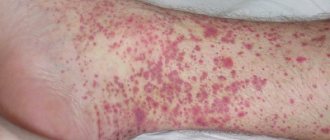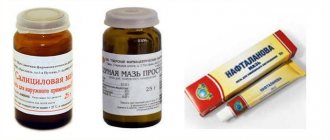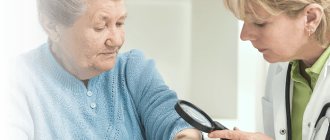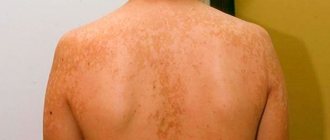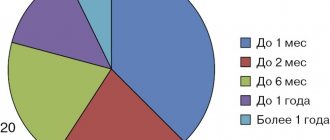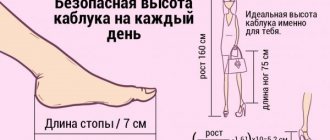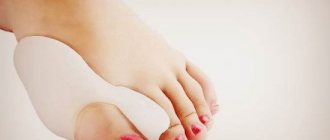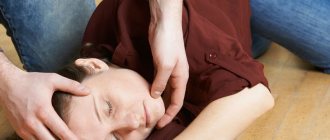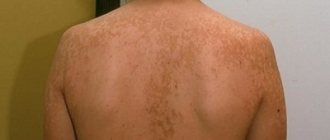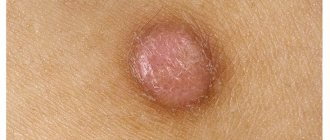General information
The name “solar lichen” is accepted in everyday life; in fact, the disease is called pityriasis versicolor (varicolored) lichen .
This is a long-term fungal infection of the stratum corneum of the epidermis, which most often occurs in people vacationing in resort areas. This is why it is also sometimes called “sun fungus.” This disease is characterized by the appearance of peeling and white spots with irregular outlines. The spots can also be multi-colored. They usually appear on the neck and back, but can also be observed on other parts of the body. These spots do not tan even if the person is exposed to sunlight. Since he does not feel any pain or itching, he can “write off” these manifestations as an uneven tan and believe that in some places his skin is burnt, as a result of which such a reaction is noted. But in fact, the disease is of fungal origin. Under normal conditions, when the majority of the skin is hidden under clothing and does not tan, such a manifestation may not be noticed. However, during the hot period, when a person is in the sun, depigmentation becomes especially noticeable.
This article will discuss how to recognize sun fungus and distinguish it from other skin diseases, as well as methods of treating the disease.
What is pityriasis versicolor
Pityriasis versicolor is a disease
of the stratum corneum
of the skin
caused by yeast-like fungi of the genus Pityrosporum or Malassezia. Pathogenic fungi are present on the surface of the body of most people, but they affect epidermal cells only when exposed to unfavorable factors:
- increased sweating, hyperhidrosis;
- long-term hormonal therapy;
- wearing clothes and underwear made of synthetic materials;
- failure to comply with personal hygiene rules;
- weakening of skin barrier functions due to peeling, exposure to chemical and organic substances.
The development of pityriasis versicolor can be facilitated by an “ulcerative” infection of Helicobacter pylori, which causes systemic inflammation and disruption of the mechanisms of barrier protective functions of the skin. Thus, the Turkish Journal of Medical Sciences in June 2022 published research data according to which the carriage of Helicobacter pylori changes the microenvironment of the skin and increases the tendency for its cells to be damaged by a yeast-like fungus.
Pathogenesis
The disease belongs to the group of superficial dermatomycosis. The development of solar lichen occurs under the influence of fungi of the genus Malassezia furfur . This is a yeast-like fungus. It is lipophilic, meaning it feeds on fats. On the skin, it is fueled by excess sebum and skin cells. In most people (about 90%), this fungus in the form of a blastospore is a component of normal microflora . However, under the influence of certain factors, the fungus transforms into a pathogenic form.
In addition to lichen, this fungus also causes the development of seborrhea , seborrheic dermatitis , dandruff and other diseases.
The disease most often affects people in hot and humid climates. According to statistics, approximately 40% of cases of the disease are diagnosed in the tropics and subtropics.
Under certain conditions, the Malassezia furfur mushrooms secrete azelaic acid , which affects the process of melanin . When cells containing melanin are destroyed, depigmentation of the skin occurs. This causes the skin to develop sun spots. When the skin is exposed to the sun, Malassezia furfur secretes a protective pigment and some spots turn brown.
Complications
When asked why solar lichen is dangerous, many dermatologists answer that the disease is only a cosmetic defect. There is also a small danger of infecting people with whom the patient is in close contact (especially if they often suffer from colds or have other pathologies that reduce immunity).
Some experts note that if solar lichen is not treated, more serious consequences may develop in areas where the fungus has spread: areas of suppuration, weeping eczema. The resulting itching and desire to get rid of stains lead to neuroses.
Causes
The fungus can become pathogenic under the influence of a number of factors, including:
- Staying in a hot and humid climate, constantly overheating due to wearing too warm clothes or excessively high temperatures.
- Excessive sweating, changes in the chemical composition of sweat.
- Very active sebum production.
- Teenage years.
- Violation of metabolic processes.
- Hormonal imbalance.
- Overweight.
- The use of certain medications - immunosuppressants, contraceptives, cytostatics, etc.
- Hereditary tendency.
- Failure to comply with hygiene standards.
- Wearing poor quality clothes
- Pregnancy , menopause and associated hormone surges.
- Immunodeficiency – HIV, period of treatment of oncological diseases and malignant tumors, etc.
- High level of acidity of the skin.
- A number of serious diseases that lead to deterioration of immunity .
- Use of oil and fat based cosmetics.
It is noted that people aged 10 to 40 years most often fall ill. But sometimes the disease is diagnosed in young children, as well as in older people. Since it develops against the background of deteriorating immunity, it most often occurs in spring and autumn.
Symptoms of solar lichen
Photo of solar lichen in a person
The main symptoms of the disease are the appearance of spots that do not tan in the sun, as well as peeling of the skin.
The spots are small and have clear boundaries. They can be white, yellowish, brown, pink. Most often the back, shoulders, armpits, neck, and chest are affected. Spots rarely appear on the legs, arms and face.
The spots may coalesce and form large lesions, but sometimes they remain isolated. There is no inflammation, but the skin peels off slightly due to loosening of the stratum corneum.
If a fungal infection is joined by a bacterial one, the following symptoms may occur:
- Heavy sweating.
- Itching.
- Burning sensation.
- Signs of an inflammatory process.
Tests and diagnostics
If you suspect the development of this disease, you should consult a dermatologist. The doctor examines and interviews the patient, and also conducts a number of studies. During the survey, he is interested in concomitant diseases, as well as under what conditions the spots appeared on the skin.
To diagnose pityriasis versicolor, an iodine test (Balzer test) is performed. The skin in the affected areas is lubricated with iodine tincture, and then wiped with alcohol. The layer of skin affected by the mushroom quickly absorbs iodine. It colors the spots of lichen, and they stand out sharply against the background of healthy skin.
A microscopic analysis of skin scrapings is also carried out, during which threads of the fungus with rounded cells are determined. By analyzing the presence of fungus in scrapings, you can confirm the fungal nature of the disease.
Examination under Wood's lamp is carried out in a dark room. Foci of lichen glow with a red-yellow, green-blue or brown glow.
Diagnosis is carried out, first of all, in order to distinguish the disease from a number of other diseases: vitiligo , secondary syphilis , pink zhibert , seborrhea , etc.
Therapy
Treatment of solar lichen is a very painstaking matter, it is carried out at home. There are a great variety of drugs, and only a dermatologist can select one or more that are suitable in this particular case.
Unfortunately, there are no universal combinations for treating solar lichen, but we will look at those medications that, according to reviews from real people, help.
Fungicidal preparations
These are fungal killers. They can be systemic (in the form of tablets or capsules) and local.
Fluconazole is used as a systemic drug for solar lichen. It is taken for 2 days, 150 mg. After a week, repeat 300 mg. This is where the treatment ends.
The following antifungal ointments are used to treat solar lichen: Clotrimazole, Nizoral, Lamisil, Exoderil. They are applied 1-2 times a day for a week, then a break is taken for a month, after which the two-week course is repeated.
If you need to treat an area of lichen on the head, it is first recommended to wash your hair with an antifungal shampoo (Nizoral, Dermazol, Perhotal, Sebozol), and then apply a fungicidal ointment to it.
Keratolytic drugs
These are products for exfoliating the surface layers of the skin along with the pathogen. These include 2% alcohol solutions of salicylic acid or resorcinol, 50% urea ointment, Arievich ointment. They are applied frequently - every 3 hours.
Such drugs are especially good in the initial stages of lichen. They can also be used in conjunction with antiseptics with antifungal activity. First, a keratolytic is applied to the lesions of lichen, and then iodine, a solution of fucorcin or Miramistin.
Preparations based on zinc pyrithione
Effective remedies for solar lichen are zinc-based medications: “Psorilom”, “Skin-cap”. The latter is available in the form of a cream (it is applied to the skin of the body) or a spray (it is better to treat the scalp).
Non-drug treatment
During the course of treatment for lichen, it is necessary to strengthen hygiene measures:
- take a shower twice a day, and then blot the affected areas with a clean towel (it is washed after each use);
- dress so as not to sweat;
- During treatment, avoid activities that will make you sweat;
- change your underwear daily, after ironing it;
- do not scratch the affected areas.
Treatment with folk remedies
Some folk remedies can be used as additional methods to promote a speedy recovery. You should first discuss their use with your doctor.
- Product with zinc - mix zinc and glycerin in equal proportions, add a little talc. Apply the product twice a day to the skin.
- Calendula tincture - the flowers should be filled with alcohol (one part of flowers and five of alcohol). Leave for 10 days, then wipe the skin with the product three times a day. If irritation occurs, you can dilute the infusion with water.
- Buckwheat compress - boil buckwheat, cool and apply to affected areas once a day for 1 hour.
- Means for wiping - the places where the heel has formed must be wiped with cranberry juice, apple cider vinegar, burdock oil.
Goodbye beach?
Pityriasis versicolor itself can be successfully treated. The course can last from 2–3 weeks to several months. But sometimes a long-term process with periodic exacerbations is possible. The reason, as a rule, is non-compliance with the prescriptions by the patients themselves. However, sometimes appointments are also lame. Among the common treatment errors is the prescription of quartz procedures. Especially during periods of exacerbation. Then there is no need to discuss with the doctor. It should be changed immediately.
However, the most common reason for prolonged treatment and subsequent exacerbations is non-compliance with prescribed prophylaxis. By the way, it cannot be called tedious. Doctors, for example, recommend using ... medicated anti-dandruff shampoos as a shower gel. And then wipe the skin with diluted lemon juice. In summer, it is enough to repeat this procedure 2-3 times a week. Most importantly, tan lovers need to think about whether it is worth exposing their skin to stress and testing in pursuit of a beautiful movie tan. Although sunbathing after treatment is not prohibited, you still need to do it wisely and without abuse.
Prevention
To prevent the appearance of sun lichen, you should adhere to the following rules:
- Take measures to overcome excessive sweating. It is worth going to the shower and changing clothes more often, and using special creams.
- Avoid overheating and always dress appropriately for the weather.
- Do not use other people's hygiene products.
- Wear high-quality clothes made from natural fabrics.
- Eat right and live a healthy life to support your immune system. If necessary, periodically drink vitamin and mineral complexes.
- Treat all diseases in a timely manner.
- Choose the right cosmetics, using only those that suit the individual.
Diet
Diet for lichen
- Efficacy: therapeutic effect after 2 weeks
- Duration: a month or more
- Cost of products: 1400-1500 rubles per week
Proper nutrition during the treatment period contributes to a more active fight against the fungus.
It is recommended to consume the following products:
- Dairy
- Vegetables, greens.
- Whole grain products.
- Lean meat and fish.
- Nuts.
- Honey.
The following should be excluded from the diet:
- Spices, sauces.
- Marinades.
- Spicy food.
- Alcohol.
It is recommended to limit the amount of coffee, cocoa, animal fats, and sweets.
